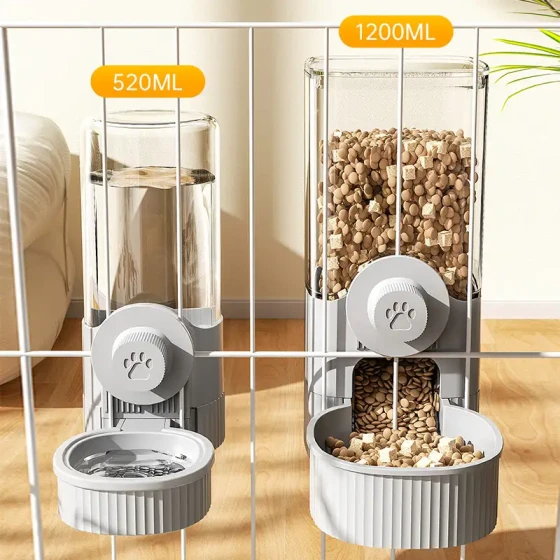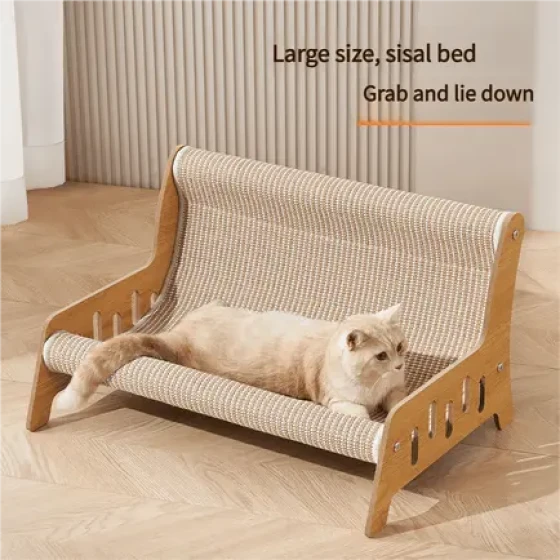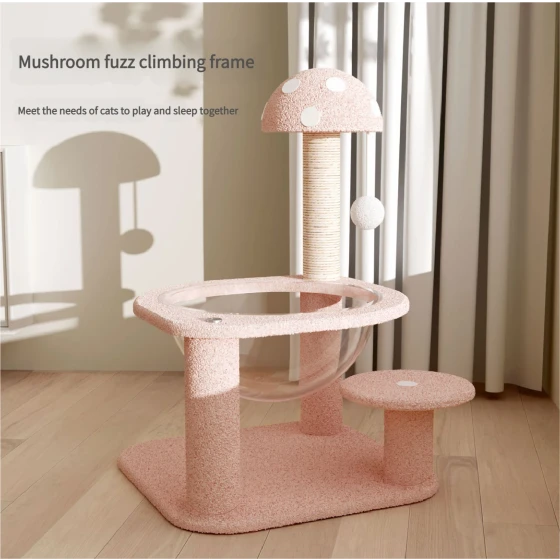What is Needed to Raise a Cat_List of Essential Items and Precautions for New Cat Owners
What is needed to raise a cat? For beginners, welcoming a kitten home is both exciting and a serious matter. Preparing in advance and understanding the cat's needs and precautions allows you to provide a warm and comfortable new home for your furry friend and start a happy “pooper scooper” life. Overall, raising a cat requires not only preparing basic living supplies but more importantly, mental readiness, dedicating time and energy to care for them, and paying attention to their health and behavior habits.
Mental preparation before raising a cat: This is not an impulse decision
Before bringing a cat home, ask yourself: Are you ready to welcome a “little ancestor” who will accompany you for more than ten years, maybe even longer? Raising a cat is not a whim; it requires your love, patience, and responsibility. You need to accept that cats may scratch furniture, shed fur everywhere, and do “night time parkour,” and you must spend time daily to play and interact with them. Raising a cat is a significant responsibility that requires long-term commitment, so consider carefully.
Essential item checklist for new cat owners: Giving your master a comfortable new home
Just like preparing furniture when moving to a new house, welcoming a cat home requires a series of living supplies. This list will help you manage your cat’s “food, clothing, shelter, and transportation,” helping them adapt quickly to their new environment:
-
Food issue: People live to eat, and so do cats!
- Cat food: Choosing cat food suitable for the cat’s age and needs is crucial. Kittens, adult cats, senior cats, and cats with special health conditions all have corresponding foods. Prioritize big brands with good reputations and purchase through official channels to avoid pitfalls. Newly arrived cats may experience stress, so having some canned food as a backup can help stimulate their appetite.
- Food bowls and water bowls: It is recommended to choose bowls made of ceramic or stainless steel, which are less likely to harbor bacteria and easy to clean, effectively preventing the “black chin” problem in cats. It’s best to prepare two bowls: one for food and one for water, and keep them separate to avoid water contamination. Elevated and slant-designed bowls are more suitable for cats to eat from and can reduce neck strain.
- Drinking water: Ensure cats have access to clean, fresh drinking water at all times. Some cats prefer running water, so consider preparing a pet water fountain. Try to give cats cooled boiled water or purified water and avoid mineral water to prevent urinary stones.
-
Convenient place: Solving the cat’s “internal emergency”
- Litter box: This is the cat’s exclusive toilet and is indispensable. Choose a litter box of appropriate size, preferably a bit bigger so the cat can use it even after growing up. Closed or semi-closed litter boxes reduce litter scatter and keep the environment tidy. Place the litter box in a quiet place that is easily accessible for the cat and far from food and water bowls.
- Cat litter: There are many types of cat litter such as tofu litter, bentonite litter, pine litter, etc. Tofu litter has low dust and is easy to handle; it can be flushed down the toilet, making it a good choice. Try to select litter with good deodorizing effect, strong absorbency, and good clumping.
- Litter scoop: Used daily to clean the cat’s waste and keep the litter box clean.
-
Comfortable nest: Giving your cat a sense of security
- Cat bed: Prepare a comfortable and warm cat bed, placed in a quiet and safe spot such as a corner of a room or a high place. New cats may feel insecure; a cardboard box or a narrow space can also make them feel safe. Cats sleep most of the day, so a comfortable cat bed is very important to them.
- Cat tree/cat scratching board: Cats have a natural instinct to scratch. Providing scratching boards or cat trees can redirect their attention and prevent furniture from being scratched. Scratching boards come in various materials and shapes, choose according to your cat’s preferences. Place them near the cat’s usual spots or near furniture you don’t want scratched.
-
Travel tools: Must-haves for taking your cat out
- Cat carrier/airline carrier: Used to take cats to the vet or outside. Choose breathable, sturdy, and spacious carriers so your cat feels safe and comfortable inside. Hard-shell carriers are safer than soft bags and less likely to allow cats to escape.
-
Playtime: Releasing your cat’s energy
- Cat toys: Cats need toys to stay active and satisfy their curiosity and hunting instincts. Teaser wands, plush toys, noise-making balls are good choices. Spend time playing with your cat daily to increase their exercise and strengthen the bond between you and your cat.
-
Grooming and care: Keeping your master clean and tidy
- Comb: Regularly combing your cat removes dead hair, reduces shedding, and promotes blood circulation for healthier fur.
- Nail clippers: Regularly trim your cat’s nails to avoid scratching furniture or themselves.
- Pet wet wipes/cleaning supplies: Used for daily cleaning, such as wiping secretion from your cat’s eyes and ears.
Precautions for new cat owners: Details determine success or failure
Besides material preparation, new cat owners need to pay attention to some important details that determine whether the cat can smoothly adapt to the new environment and grow healthy:
-
New cat arrival: Give it time and space
- Isolation and familiarization: New cats may be nervous and scared, hiding is a normal stress response. Provide an independent, quiet space (such as a room), place food, water, and litter box, and let it slowly adapt to the new environment. Don’t force it out or disturb it excessively.
- Gradual progress: Once the cat adapts, it will slowly explore and approach you actively. You can use treats or toys to entice it and build trust.
- Multi-cat households: If you already have other cats, isolate the new cat for a period (like one week), let them familiarize by scent first to avoid conflicts from direct contact.
-
Safety first: Protecting your cat’s curiosity
- Window screens: Cats are curious and like climbing and observing outside. Make sure to install sturdy screens or protective nets to prevent accidental falls.
- Store away dangerous items: Cleaning agents, medicines, wires, needles, small buttons, and other dangerous items should be stored properly to prevent ingestion or contact. Some human foods (like onions, garlic, chocolate, grapes) are toxic to cats and must never be fed.
- Create safe hiding spots: Cats like concealed places. Providing cardboard boxes or elevated platforms can make them feel secure.
-
Health management: Regular check-ups and vaccinations
- First health check: After bringing your cat home, take it to a vet as soon as possible for a comprehensive health check including deworming and vaccinations. The vet will provide professional advice based on your cat’s condition.
- Regular deworming and vaccinations: Follow the vet’s guidance to deworm and vaccinate regularly to prevent parasites and infectious diseases.
- Observe your cat’s condition: Pay attention to your cat’s spirit, appetite, and excretion; seek vet help immediately if abnormalities appear.
-
Behavior habits: Patient guidance and training
- Litter training: Most cats naturally use the litter box. Providing a proper litter box and cat litter in an accessible place will enable them to quickly learn to eliminate in designated areas.
- Socialization: If the cat is still young, try exposing it to different people and friendly animals to help improve socialization and reduce fear of new environments and things.
Possible “minor incidents” new cat owners may encounter: Don’t panic, take it slow
During the process of raising a cat, you may encounter some “small troubles,” such as the cat not eating or drinking after arrival, urinating and defecating randomly, or meowing at night. These are normal and don’t worry too much.
- Stress reaction: The new environment is a huge challenge for cats, so stress reactions are common. Give it time and space to adapt and provide familiar scents (like bedding from the old home) to gradually build trust.
- Random urination and defecation: First check if the litter box is clean, if the litter is suitable, and if the placement is appropriate. If none of these, it could be illness or behavioral issues; consult a vet or pet behavior specialist.
- Night meowing: Cats are nocturnal and being active at night is normal. Spend more time playing with your cat during the day to burn energy and provide a comfortable sleeping environment at night; the situation may improve.
Frequently Asked Questions
- Do cats need baths? How often?
Cats are very clean and groom themselves, so frequent bathing is unnecessary. Generally, bathe every 3-6 months or as needed based on your cat’s condition. Frequent baths may damage the natural oil layer on the cat’s skin. - Do cats need to be neutered?
Neutering has many health benefits for cats, reducing the risk of certain diseases, extending lifespan, and decreasing behavioral problems related to heat cycles. Consult a vet to choose the appropriate time for the procedure. - Can cats eat human food?
It’s best not to feed cats human food, especially toxic foods like chocolate, onions, garlic, and grapes. Human food has different nutritional content from what cats need and long-term feeding may cause malnutrition or health issues. - Is it good for cats to wear bells?
Cats have very sensitive hearing; the sound of bells may affect their hearing and cause discomfort and stress if worn long-term.
Summary:
Raising a cat is a journey full of love and responsibility. Although it requires time and effort, the companionship and joy cats bring are irreplaceable. Hopefully, this beginner’s guide helps you prepare better, welcome your furry friend home, and start a wonderful life together! Remember, patience, love, and scientific care methods are key to becoming a qualified “pooper scooper.”





